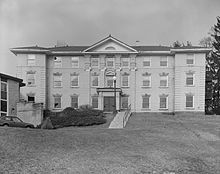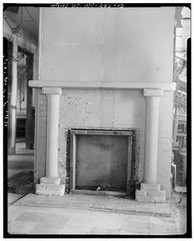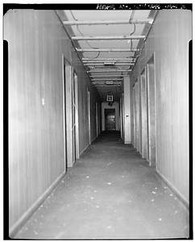Whitescarver Hall
Introduction
Text-to-speech Audio
Images
Whitescaver Hall

Whitescarver Chimney

Whitescarver Hallway

Backstory and Context
Text-to-speech Audio
In 1911, two architects from Clarskburg and S.T.H. Holt of Phillipi began construction on the Hall with a $175,000 grant in hand. The building was constructed of sandstone, red and white brick, and included both gas and electric lighting, plumbing, a functional fireplace, several lobbies, a boiler room, Victorian staircase, and operating showers on each floor. The cornerstone foundation was laid by George M. Whitescarver, which the school named the Hall after him as a gift from the college. The forty by ninety foot three-story Whitescarver Hall is one of the oldest, surviving landmarks, and one of the three original structures on the A-B campus. After its completion in 1912, twenty men moved into the dorm and held several ceremonies for the Hall's completion and for Whitescarver, or as the students referred to him, Uncle George.
George Whitescarver (1831-1914) was a carpenter, manager for the Baltimore & Ohio railroad business, and owner of a lumbering business in Randolph County. Amongst his many roles, Whitscarver joined one of the first land battles of the Civil War as a private. In addition, Whitescarver invested in real estate, coal mines, and a brick laying business, which won him an award at the 1893 Chicago's World Fair. Whitescarver also was a stockholder on the Board of Directors of the First National Banks for Gafton and Parkersburg. Whitescarver's connections to the school are emphasizes through his role in the school's Board of Trustees, which he served on until his death, three years after the Hall's completion.
Between 1912-1950s, the building served as a male-only dormitory, and later it served as a student residence hall between the 1950s-1970s, which marked the Hall's transition from a male-only dormitory to a co-ed dormitory. Later, it was used as an administrative office until the completion of the new administration building, New Main in 1980.The Hall's structure of the Classical Revival Style is one of the reasons for the Hall's significance because it is an artifact of the architectural style in the Phillipi and Barbour County area. Although there were some damage to the property and additional fire escapes added on, Whitescarver Hall is still preserved as a historical, educational site in West Virginia.
Sources
Daddysman, James W. National Register of Historic Places Inventory Nomination Form: Whitescarver Hall, West Virginia Division of Culture and History, Historic Preservation. June 1989. Accessed October 14th 2019. http://www.wvculture.org/shpo/nr/pdf/barbour/89002317.pdf.
George M. Whitescarver (1831-1914), WVGenWeb.n.d. Accessed October 14th 2019. http://www.wvgenweb.org/taylor/bios/whitescarver_george-m.html.
https://en.wikipedia.org/wiki/Whitescarver_Hall#/media/File:Whitescarver_Hall.jpg
https://upload.wikimedia.org/wikipedia/commons/thumb/2/2d/FIRST_FLOOR%2C_FIREPLACE_-_Alderson-Broaddus_College%2C_Whitescarver_Hall%2C_West_side_of_U.S._119-250%2C_North_of_covered_bridge%2C_Philippi%2C_Barbour_County%2C_WV_HABS_WVA%2C1-PHIL%2C1-A-10.tif/lossy-page1-615px-thumbnail.tif.jpg
https://upload.wikimedia.org/wikipedia/commons/thumb/0/06/SECOND_FLOOR%2C_HALLWAY_LOOKING_SOUTH_-_Alderson-Broaddus_College%2C_Whitescarver_Hall%2C_West_side_of_U.S._119-250%2C_North_of_covered_bridge%2C_Philippi%2C_Barbour_County%2C_WV_HABS_WVA%2C1-PHIL%2C1-A-13.tif/lossy-page1-823px-thumbnail.tif.jpg
